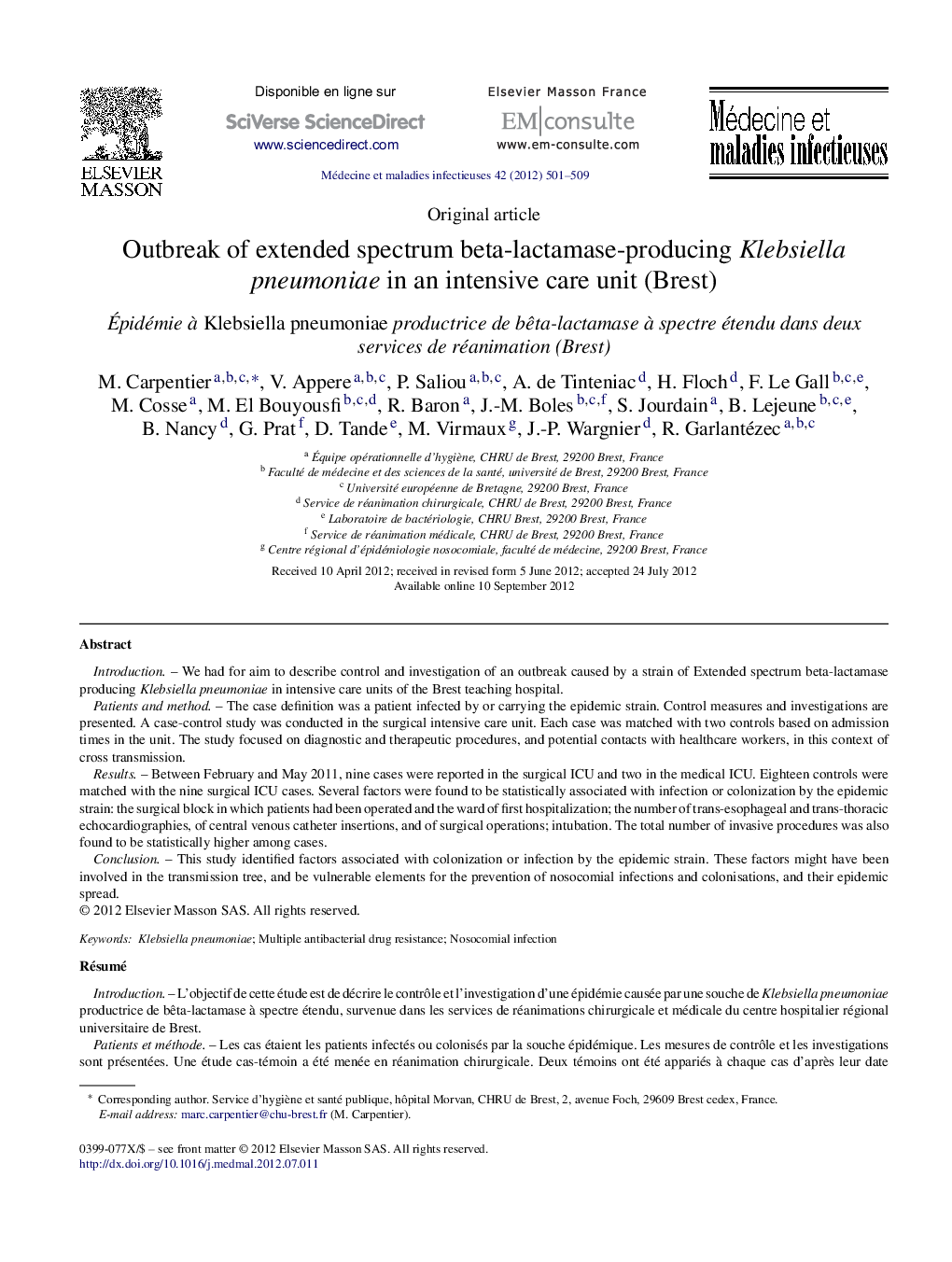| Article ID | Journal | Published Year | Pages | File Type |
|---|---|---|---|---|
| 3412726 | Médecine et Maladies Infectieuses | 2012 | 9 Pages |
IntroductionWe had for aim to describe control and investigation of an outbreak caused by a strain of Extended spectrum beta-lactamase producing Klebsiella pneumoniae in intensive care units of the Brest teaching hospital.Patients and methodThe case definition was a patient infected by or carrying the epidemic strain. Control measures and investigations are presented. A case-control study was conducted in the surgical intensive care unit. Each case was matched with two controls based on admission times in the unit. The study focused on diagnostic and therapeutic procedures, and potential contacts with healthcare workers, in this context of cross transmission.ResultsBetween February and May 2011, nine cases were reported in the surgical ICU and two in the medical ICU. Eighteen controls were matched with the nine surgical ICU cases. Several factors were found to be statistically associated with infection or colonization by the epidemic strain: the surgical block in which patients had been operated and the ward of first hospitalization; the number of trans-esophageal and trans-thoracic echocardiographies, of central venous catheter insertions, and of surgical operations; intubation. The total number of invasive procedures was also found to be statistically higher among cases.ConclusionThis study identified factors associated with colonization or infection by the epidemic strain. These factors might have been involved in the transmission tree, and be vulnerable elements for the prevention of nosocomial infections and colonisations, and their epidemic spread.
RésuméIntroductionL’objectif de cette étude est de décrire le contrôle et l’investigation d’une épidémie causée par une souche de Klebsiella pneumoniae productrice de bêta-lactamase à spectre étendu, survenue dans les services de réanimations chirurgicale et médicale du centre hospitalier régional universitaire de Brest.Patients et méthodeLes cas étaient les patients infectés ou colonisés par la souche épidémique. Les mesures de contrôle et les investigations sont présentées. Une étude cas-témoin a été menée en réanimation chirurgicale. Deux témoins ont été appariés à chaque cas d’après leur date d’admission. Dans ce contexte de transmission croisée, l’étude s’est intéressée en particulier aux actes diagnostiques et thérapeutiques et aux passages des professionnels de santé.RésultatsEntre février et mai 2011, neuf cas en réanimation chirurgicale et deux cas en réanimation médicale ont été observés. Dix-huit témoins ont été appariés aux neuf cas de réanimation chirurgicale. Plusieurs facteurs ont été trouvés associés à la colonisation ou à l’infection : le bloc opératoire d’origine et le service d’origine; les nombres d’échographies trans-œsophagiennes et trans-thoraciques, le nombre de poses de cathéters veineux centraux et d’interventions chirurgicales; l’intubation. Le nombre total d’actes invasifs était également statistiquement plus élevé chez les cas.ConclusionCette étude a mis en évidence des facteurs associés à la colonisation ou à l’infection des patients par la souche épidémique, qui pourraient avoir caractérisé la chaîne de transmission et constituer des éléments de vulnérabilité dans la prévention des infections ou colonisations nosocomiales et de leur diffusion épidémique.
